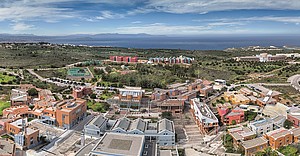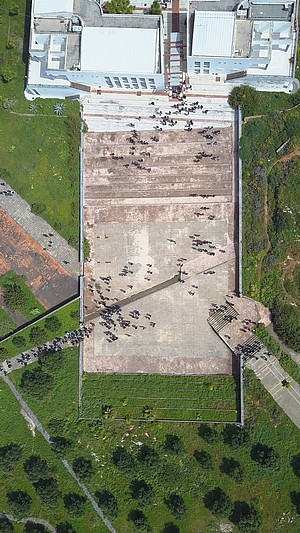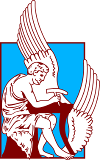Mission and History
Mission
TUC is a small, young, dynamic University with a clear mission: to expand knowledge and benefit society through research integrated with education. In this endeavour, the pursuit of excellence is the driving force. More than 70 laboratories with prime equipment, high technology infrastructure and eminently qualified personnel, as well as 120 faculty and staff members with international academic background attest to the level of excellence in education and research conducted at the University. This profile ranks the Technical University of Crete amongst the most prominent research institutions in Greece.
History



Soon after the end of the German occupation of Greece, the issue of establishing a University on Crete was brought up and reached its peak during the 1960’s. However, although public demand for the establishment of a university on Crete was unanimous, there was also an intense rivalry between the two major cities on the island on which one would become the seat of that university. Finally, the solution to the problem was given in 1977 by the then Prime Minister Konstantinos Karamanlis, who made a balanced decision approving both the establishment of a University with faculties in Heraklion and Rethymnon and the establishment of a Technical University in Chania.
The Technical University of Crete was established by Law according to the Official Govenment Gazette No. 545/77 of 17/02/1977, on the “Establishment of a Technological Institution under the title Technical University of Crete and other provisions”. On July 17th 1977, the first Executive Committee of the Institution convened under the presidency of Professor Perikles Theoharis and in the presence of the then Minister of National Education Georgios Rallis, consisting of the Mayor of the City of Chania and the President of the Western Crete Section of the Technical Chamber of Greece, representing the local element which had shown great interest in the establishment of the University.
The main task of this first Executive Committee in 1977 was to find land for the erection of permanent university facilities by commencing the expropriation procedure of 350 hectares of land. It is worth mentioning, at this point, the immense support of the local community on this matter. At the same time, the Executive Committee also dealt with the organization and recruitment of the university services but mostly with the legal framework for its operation. As a result of the Executive Committee’s dedicated work, a great number of decrees were issued, the most important of which is the Presidential Decree 1140/80 on the “Establishment of Higher Education Schools, Departments and Research Institutes as well as posts of Professors at the Technical University of Crete”, which provided for the establishment of three Schools: a) Technical Sciences, b) Applied Sciences and c) Architecture and Spatial Planning. Each School would comprise four Departments.
Apart from its work on the legal framework of the Institution, the first Executive Committee was responsible for the acquisition of three historic buildings (Old Prisons, Old City Hall, or Arsenal and the Venetian Loggia), the drawing up of studies for their restoration as well as the drawing up of studies for the Initial University Facilities. The Committee proceeded in purchasing computers, books and 479 magazine titles for the Central University Library as well as in setting up electoral bodies for judging the candidatures for the calls for tender regarding Educational and Research Personnel positions.
After 1981, a new Executive Committee was set up under the presidency of Professor Thales Argyropoulos (1982-1988) from the Aristotle University of Thessaloniki and later, under the presidency of Professor Theodore Lianos (1988-1989) who was a faculty member of the Higher School of Economic and Commercial Studies (ASOEE).
The new Executive Committee completed or revised decisions of the former administration with reference to basic issues such as the housing problem and the educational programming. As far as the housing problem was concerned, it gave priority to the development of the University inside the city by renovating the Old Venetian Prisons and Barracks, acquiring and renovating the former French School, acquiring the Military Division complex of buildings by the Ministry of National Defence, securing the use of the Hatzidakis camp in Halepa and putting forward studies for the erection of buildings on it. At the same time, the project of the erection of university facilities in Akrotiri was put forward while the expropriated land for this purpose had been cut down by 60 hectares compared to the initial surface. The foundation ceremony of the university facilities in Akrotiri took place in December 1988.
As far as the educational programming was concerned, significant changes took place, based, of course, on the new legal framework that had started to form in the meanwhile but had definitely reversed the programming of the Executive Committee of 1977. The capstone of the philosophy of the Executive Committee of 1981, with reference to the educational programming, was the issuing of the Presidential Decree52/83 on “the structure of the Technical University of Crete into Departments and Sectors, the procedure of electing permanent faculty members and prerequisites on the independent function of the Technical University of Crete with elected governing bodies”. Instead of three Schools and 12 Departments that were provided for in the P.D. 1140/80, the new P.D. 52/83 provided for the establishment of 6 Academic Departments: Production Engineering and Management, Mineral Resources Engineering, Electronic Engineering, Chemical Engineering, Mechanical Engineering and Sciences Department.
In 1984, the first faculty members were appointed. During the academic year 1984-85, the Production Engineering and Management Department started running its educational programme and admitted its first 120 students together with the Sciences Department. The Mineral Resources Engineering Department followed in 1987-88 and the Electronics and Computer Engineering Department in 1990-91. Later on, and after the University had become independent, the Chemical Engineering Department became an Environmental Engineering Department and admitted its first students in 1997. Finally, in 2004 the Architectural Engineering Department was established and welcomed its first students.
In September 1989, the new Executive Committee, presided by the Professor of the National Technical University of Athens Ioannis Tegopoulos together with the Professors of the Technical University of Crete Antonis Foskolos and Joachim Gryspolakis as vice-presidents, decided to change the spatial planning orientation of the expansion of the university. They abandoned the idea of further expanding the university within the city of Chania and rapidly promoted the development of the facilities of the university in Akrotiri. The University assigned facilities such as the Hatzidakis camp and the Venetian Loggia to the Municipality of Chania for other uses. The buildings that were kept in order to be used by the university itself include the Venetian Complex of the Old Prisons and Barracks, which now house the Rectorate offices as well as the offices of administrative and financial services, whereas the facilities of the former French School in Halepa now accommodate the Department of Architectural Engineering. In this way, the University maintains its necessary cohesion with the city of Chania and its social fabric. But, most important of all, this policy enabled the housing of the rest of the academic departments of the university within campus in Akrotiri, which offered the possibility for the erection of suitable lecture halls, laboratories and infrastructure that modern requirements dictate for a Technical University.
In 1993, all the necessary legal requirements were met and thus, all the Departments of the University became independent and have been operating since then with elected governing bodies. As soon as these requirements were met, the procedure for the election of a Rectorate was initiated, thus establishing the independent operation of the Technical University of Crete. Professor Yannis Phillis became the first Rector of the Technical University of Crete assisted in his functions by the Vice-Rectors Professors Ioannis Siskos and Theodore Markopoulos, who took on their office on 08/12/1993.
Since then, the Technical University of Crete has been making continuous and significant progress. The high quality of the faculty staff, the scientific partners and the administrative and technical personnel guarantee the University’s future growth. The campus is certainly one of the best in Greece, with modern lecture halls and research facilities, library, student hall of residences, restaurant and recreational areas. New Departments are scheduled for the future and at the same time, the contribution of the Technical University of Crete in research is broadly appreciated, as the Institution is now recognized as one of the most prestigious research institutions in Greece with hundreds of research programmes in progress. The Technical University of Crete is now recognized both as an educational and research institution in Greece and internationally and can therefore envision with great optimism its future.
Future Goals
- Emphasis on providing top quality education
- Conducting innovative research
- Creation of a Regional Innovation Pole and Technological Park
- Support innovation
- Cooperation with local authorities in solving environmental and organizational problems.

The Technical University of Crete Emblem
Daedalus building wings
The emblem of the University represents Daedalus, an architect and inventor in Greek mythology, to who are attributed great primordial works of architecture and sculpture. His art was said to be so exquisite that his statues looked like they would come to life and start moving. Daedalus was said to have manufactured, among others, the exemplary labyrinth for King Minos of Crete. Later, he fell into dismay with King Minos and was imprisoned inside his most perfect of his works, the labyrinth. It was then that he built wings out of wax for his son Icarus as well as himself. Icarus however flew too close to the sun and fell to his death when his wax wings melted.















